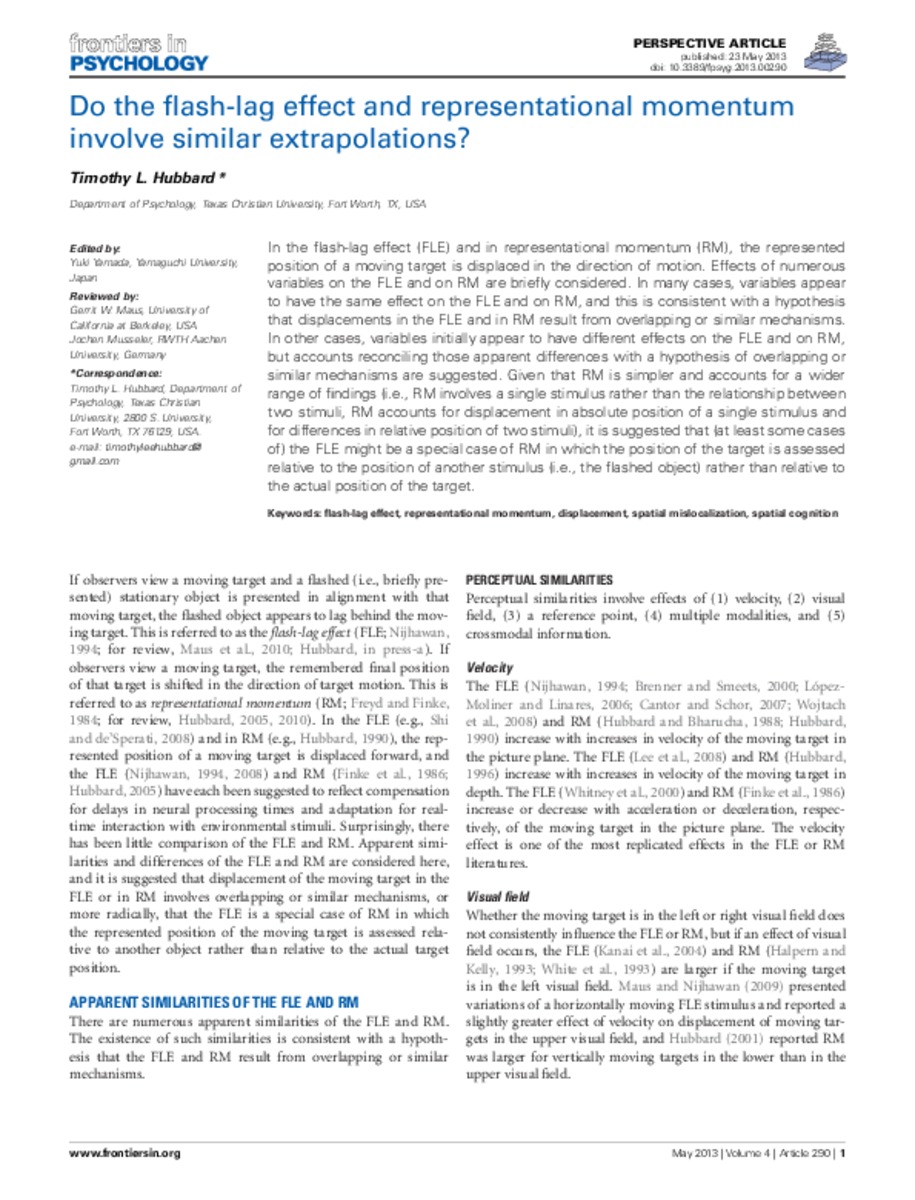Do the flash-lag effect and representational momentum involve similar extrapolations?Show full item record
| Title | Do the flash-lag effect and representational momentum involve similar extrapolations? |
|---|---|
| Author | Hubbard, Timothy L. |
| Date | 2013-05-23 |
| Abstract | In the flash-lag effect (FLE) and in representational momentum (RM), the represented position of a moving target is displaced in the direction of motion. Effects of numerous variables on the FLE and on RM are briefly considered. In many cases, variables appear to have the same effect on the FLE and on RM, and this is consistent with a hypothesis that displacements in the FLE and in RM result from overlapping or similar mechanisms. In other cases, variables initially appear to have different effects on the FLE and on RM, but accounts reconciling those apparent differences with a hypothesis of overlapping or similar mechanisms are suggested. Given that RM is simpler and accounts for a wider range of findings (i.e., RM involves a single stimulus rather than the relationship between two stimuli, RM accounts for displacement in absolute position of a single stimulus and for differences in relative position of two stimuli), it is suggested that (at least some cases of) the FLE might be a special case of RM in which the position of the target is assessed relative to the position of another stimulus (i.e., the flashed object) rather than relative to the actual position of the target. If observers view a moving target and a flashed (i.e., briefly presented) stationary object is presented in alignment with that moving target, the flashed object appears to lag behind the moving target. This is referred to as the flash-lag effect (FLE; Nijhawan, 1994; for review, Maus et al., 2010; Hubbard, in press-a). If observers view a moving target, the remembered final position of that target is shifted in the direction of target motion. This is referred to as representational momentum (RM; Freyd and Finke, 1984; for review, Hubbard, 2005, 2010). In the FLE (e.g., Shi and de'Sperati, 2008) and in RM (e.g., Hubbard, 1990), the represented position of a moving target is displaced forward, and the FLE (Nijhawan, 1994, 2008) and RM (Finke et al., 1986; Hubbard, 2005) have each been suggested to reflect compensation for delays in neural processing times and adaptation for real-time interaction with environmental stimuli. Surprisingly, there has been little comparison of the FLE and RM. Apparent similarities and differences of the FLE and RM are considered here, and it is suggested that displacement of the moving target in the FLE or in RM involves overlapping or similar mechanisms, or more radically, that the FLE is a special case of RM in which the represented position of the moving target is assessed relative to another object rather than relative to the actual target position. |
| Link | https://doi.org/10.3389/fpsyg.2013.00290
https://repository.tcu.edu/handle/116099117/26445 https://www.frontiersin.org/articles/10.3389/fpsyg.2013.00290/full |
| Department | Psychology |
| Subject | flash-lag effect
representational momentum displacement spatial mislocalization spatial cognition |
Files in this item
This item appears in the following Collection(s)
- Research Publications [1008]
© TCU Library 2015 | Contact Special Collections |
HTML Sitemap




